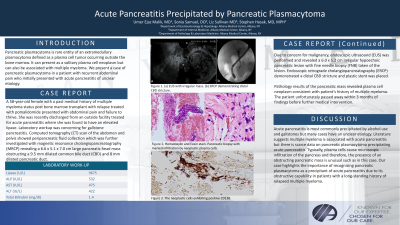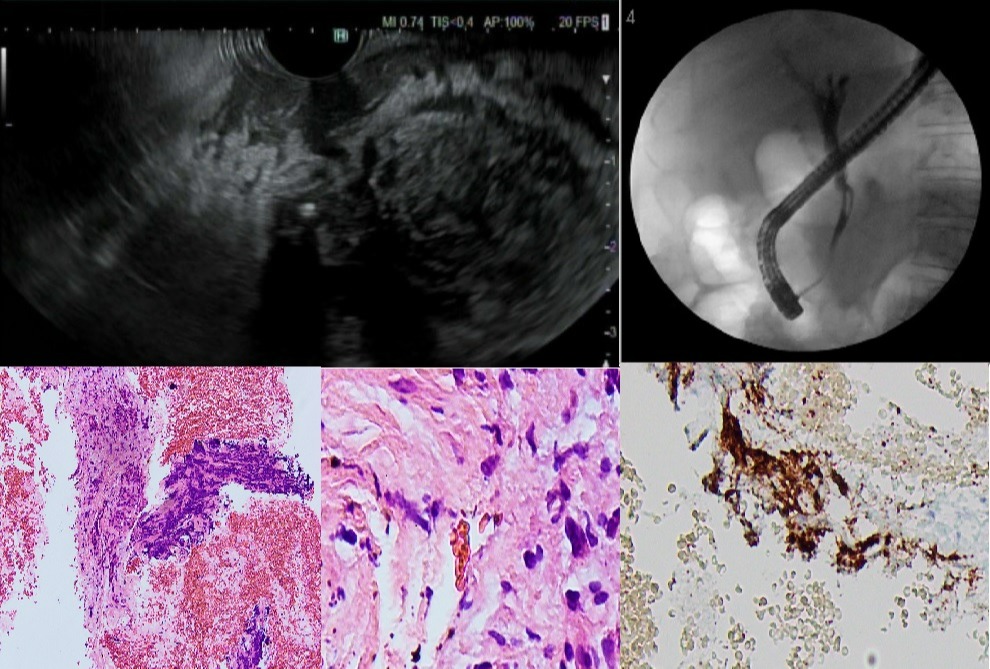Back


Poster Session B - Monday Morning
Category: Biliary/Pancreas
B0036 - Acute Pancreatitis Precipitated by Pancreatic Plasmacytoma
Monday, October 24, 2022
10:00 AM – 12:00 PM ET
Location: Crown Ballroom

Has Audio

Sonia Samuel, DO
Albany Medical Center
Albany, NY
Presenting Author(s)
Umer Ejaz Malik, MD, Sonia Samuel, DO, Luz Sullivan, MD, Stephen Hasak, MD, MPH
Albany Medical Center, Albany, NY
Introduction: Pancreatic plasmacytoma is rare entity of an extramedullary plasmacytoma defined as a plasma cell tumor occurring outside the bone marrow. It can present as a solitary plasma cell neoplasm but can also be associated with multiple myeloma. We present a case of pancreatic plasmacytoma in a patient with recurrent abdominal pain who initially presented with acute pancreatitis of unclear etiology.
Case Description/Methods: A 58-year-old female with a past medical history of multiple myeloma status post bone marrow transplant with relapse treated with pomalidomide presented with abdominal pain and failure to thrive. She was recently discharged from an outside facility treated for acute pancreatitis found to have an elevated lipase of 9675 U/L. Laboratory workup was remarkable for alkaline phosphatase (ALP) 532 IU/L, aspartate transaminase (AST) 475 IU/L, alanine transaminase (ALT) 422 IU/L, and bilirubin 1.4 mg/dl with concern of gallstone pancreatitis. Computed tomography (CT) scan of the abdomen and pelvis showed peripancreatic fluid collection which was further investigated with magnetic resonance cholangiopancreatography (MRCP) revealing a 6.6 x 5.1 x 7.0 cm large pancreatic head mass obstructing a 9.5 mm dilated common bile duct (CBD) and 8 mm dilated pancreatic duct. Due to concern for malignancy, endoscopic ultrasound (EUS) was performed and revealed a 6.0 x 5.2 cm irregular hypoechoic pancreatic lesion with fine needle biopsy (FNB) taken of the lesion. Endoscopic retrograde cholangiopancreatography (ERCP) demonstrated a distal CBD stricture and plastic stent was placed. Pathology results of the pancreatic mass revealed plasma cell neoplasm consistent with patient’s history of multiple myeloma. The patient unfortunately passed away within 3 months of findings before further medical intervention.
Discussion: Acute pancreatitis is most commonly precipitated by alcohol use and gallstones but many cases have an unclear etiology. Literature suggests multiple myeloma is associated with acute pancreatitis but there is scarce data on pancreatic plasmacytoma precipitating acute pancreatitis. Typically, plasma cells cause microscopic infiltration of the pancreas and therefore, the presence of an obstructing pancreatic mass is unusual such as in this case. Our case highlights the importance of recognizing pancreatic plasmacytoma as a precipitant of acute pancreatitis due to its obstructive capability in patients with a long-standing history of relapsed multiple myeloma.

Disclosures:
Umer Ejaz Malik, MD, Sonia Samuel, DO, Luz Sullivan, MD, Stephen Hasak, MD, MPH. B0036 - Acute Pancreatitis Precipitated by Pancreatic Plasmacytoma, ACG 2022 Annual Scientific Meeting Abstracts. Charlotte, NC: American College of Gastroenterology.
Albany Medical Center, Albany, NY
Introduction: Pancreatic plasmacytoma is rare entity of an extramedullary plasmacytoma defined as a plasma cell tumor occurring outside the bone marrow. It can present as a solitary plasma cell neoplasm but can also be associated with multiple myeloma. We present a case of pancreatic plasmacytoma in a patient with recurrent abdominal pain who initially presented with acute pancreatitis of unclear etiology.
Case Description/Methods: A 58-year-old female with a past medical history of multiple myeloma status post bone marrow transplant with relapse treated with pomalidomide presented with abdominal pain and failure to thrive. She was recently discharged from an outside facility treated for acute pancreatitis found to have an elevated lipase of 9675 U/L. Laboratory workup was remarkable for alkaline phosphatase (ALP) 532 IU/L, aspartate transaminase (AST) 475 IU/L, alanine transaminase (ALT) 422 IU/L, and bilirubin 1.4 mg/dl with concern of gallstone pancreatitis. Computed tomography (CT) scan of the abdomen and pelvis showed peripancreatic fluid collection which was further investigated with magnetic resonance cholangiopancreatography (MRCP) revealing a 6.6 x 5.1 x 7.0 cm large pancreatic head mass obstructing a 9.5 mm dilated common bile duct (CBD) and 8 mm dilated pancreatic duct. Due to concern for malignancy, endoscopic ultrasound (EUS) was performed and revealed a 6.0 x 5.2 cm irregular hypoechoic pancreatic lesion with fine needle biopsy (FNB) taken of the lesion. Endoscopic retrograde cholangiopancreatography (ERCP) demonstrated a distal CBD stricture and plastic stent was placed. Pathology results of the pancreatic mass revealed plasma cell neoplasm consistent with patient’s history of multiple myeloma. The patient unfortunately passed away within 3 months of findings before further medical intervention.
Discussion: Acute pancreatitis is most commonly precipitated by alcohol use and gallstones but many cases have an unclear etiology. Literature suggests multiple myeloma is associated with acute pancreatitis but there is scarce data on pancreatic plasmacytoma precipitating acute pancreatitis. Typically, plasma cells cause microscopic infiltration of the pancreas and therefore, the presence of an obstructing pancreatic mass is unusual such as in this case. Our case highlights the importance of recognizing pancreatic plasmacytoma as a precipitant of acute pancreatitis due to its obstructive capability in patients with a long-standing history of relapsed multiple myeloma.

Figure: 1. EUS showing pancreatic head mass 2. ERCP with distal CBD stricture 3. H&E stain with neoplastic plasma cells and positive for CD 138.
Disclosures:
Umer Ejaz Malik indicated no relevant financial relationships.
Sonia Samuel indicated no relevant financial relationships.
Luz Sullivan indicated no relevant financial relationships.
Stephen Hasak indicated no relevant financial relationships.
Umer Ejaz Malik, MD, Sonia Samuel, DO, Luz Sullivan, MD, Stephen Hasak, MD, MPH. B0036 - Acute Pancreatitis Precipitated by Pancreatic Plasmacytoma, ACG 2022 Annual Scientific Meeting Abstracts. Charlotte, NC: American College of Gastroenterology.

